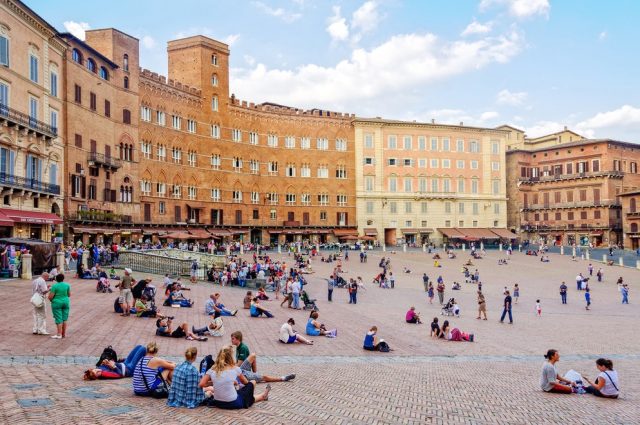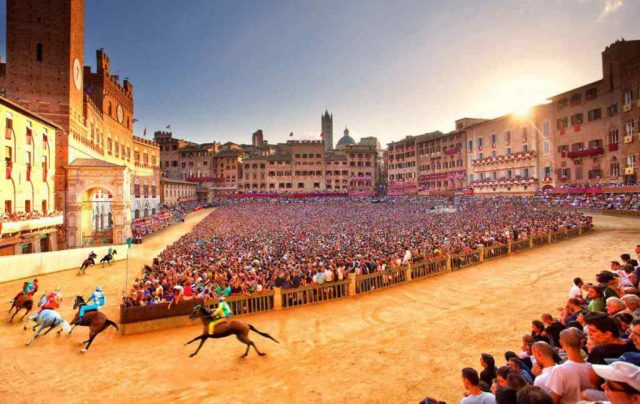There is a place where medieval knights have challenged since the dark age? Yes, this is the Palio in Siena, where you don’t need a time machine, but just visit the Piazza del Campo on the 2nd July or 16th August each year. This traditional competition runs every year with the same rules established in...
Il Palio di Siena

There is a place where medieval knights have challenged since the dark age?
Yes, this is the Palio in Siena, where you don’t need a time machine, but just visit the Piazza del Campo on the 2nd July or 16th August each year.
This traditional competition runs every year with the same rules established in the medieval age. It’s a well established game that for the Siena citizens runs all over the year with a deep tradition of “contrade”. A contrada (plural: contrade) is a district, or a ward, within an Italian city. In Siena there are 17, their names recall the nature and wild animals like AQUILA (Eagle), PANTERA (Panther), SELVA (Forest) etc.
Each Palio competition consists of ten horses, so not all seventeen contrade can take part in the Palio on any occasion. The seven contrade that did not take part in that month of the previous year are automatically included; three more are chosen by draw (so they run twice).
The preparations for the Palio are slow and methodical like a liturgical procedure.
Four days before the day of the Palio trials take place in the Piazza del Campo which is turned into a race track. A thick layer of earth is spread on the ground and a row of mattresses is placed against the walls at the dangerous corner of San Martino to protect the jockeys in case they fall.
If you see Piazza del Campo during the Palio, you won’t be able to recognise it!
The historical parade is a lively display of rich medieval costumes followed by drum players and trumpeters.
The Palio held on 2 July is named Palio di Provenzano, in honour of the Madonna of Provenzano, the Palio held on 16 August is named Palio dell’Assunta, in honour of the Assumption of Mary.
The drappellone (“banner”), or palio, known affectionately as “the rag” in Siena, is the trophy that is to be delivered to the contrada that wins the Palio.
The palio is an elongated rectangular piece of silk, hand-painted by an artist for the occasion. It is held vertically on a black-and-white shaft halberd and topped by a silver plate, with two white and black plumes draped down the sides.
The palio, along with the plumes, remains the property of the contrada. The plate is returned to the city of Siena before the two Palii of the following year, afterwards the date and the name of the victorious contrada are inscribed on its back. There is one silver platter for the Palio in July and another for the August Palio. The plates are replaced approximately every ten years.


Do and don’t
For the Sienese, the days of the Palio are days of celebrating, but also of great tension, for this reason in certain situations it is good to be careful. In particular:
– Under no circumstances should you go near the horses.
– Do not disturb the contrada members during moments of great tension, for example, during the time they accompany the horse to the trials, during the minutes before the race or after the race if they are disillusioned or angry.
– In Piazza del Campo, do not put children on your shoulders the day of the Palio: that can block the view of the others (in general, it is not advisable to bring small children in the Piazza, due to the crowds).
– Do not make sarcastic comments regarding the tension of the contrada members before the start of the race, do not protest or complain instantly if it takes a long time for the start of the race to take place.
– If the contrada members ask you to move or get away from a certain area, do as they request.
Lessico del Palio
Palio = drappo assegnato come premio
I cavalli del Palio sono cavalcati a pelo = cavalcare i cavalli senza sella
Fantino = atleta che monta il cavallo
Contradaiolo = persona che appartiene ad una contrada
Parata = sfilata storica
Dare la mossa = dare il via di inizio alla corsa
